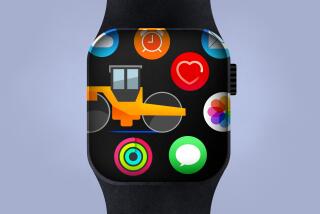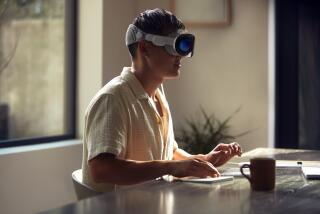Wearing the future
A wristwatch that reads your text messages out loud, a jacket that heats up when you’re cold, eyeglasses that display directions as you walk down the street.
Gimmicks, or fashion of the future?
Although those products may seem like something out of a James Bond movie, the world’s largest technology companies and start-ups alike believe “wearable tech” is the next big frontier, and they have been pouring money and research into developing high-tech clothing and accessories.
JOIN A LIVE DISCUSSION AT 1 P.M.
“It’s a function of time before wearable technology becomes real, and it’s closer than a lot of people think,” said Gene Munster, senior research analyst at Piper Jaffray. “Eventually, wearable technology is probably going to be your most easy access point to your technology.”
Google Inc., the world’s largest Internet company, has been testing augmented-reality eyeglasses that feature cameras and use voice recognition. Apple Inc. is reportedly working on a watch that would have some of the same functions as a smartphone.
The idea behind so-called wearables is to integrate technology into everyday basics, but it’s more than just inserting a gee-whiz factor into your favorite pair of jeans. Bringing tech into the fold, developers say, will create a more seamless experience with technology that involves fewer devices to carry around and less time rummaging through your purse or pocket.
But there are numerous challenges to overcome before wearable tech can become mainstream. Developers are working on improving battery life, scaling the technology down and making the products affordable.
Companies also need to persuade the public to accept the notion that digital devices and fashion can coexist in one unit by designing wearables that don’t look too techie and figuring out what kinds of functions to embed within the products.
“We have a lot of research to do,” said Cory Booth, a user experience researcher at Intel, which has a team looking into the potential for wearables. “It’s actually more about will people want to do it and how will they want to do it. When people start putting things on their bodies, it becomes very personal.”
For now, wearable tech is taking off in the sports and health markets.
Goggles made by Oakley assist snowboarders via a display that integrates GPS capabilities, Bluetooth and sensors that gauge jump analytics such as distance, height and airtime. There’s also smartphone connectivity and the ability to locate and track friends via an app.
With the Nike+ FuelBand, a wristband containing an accelerometer, wearers can set daily activity goals and track calories burned on the band’s LED display. Data from the FuelBand — which Apple Chief Executive Tim Cook has been seen wearing — can be viewed on a mobile device via an iOS app. The Up by Jawbone wristband and Fitbit wireless activity trackers are similar products that help users eat and sleep better and record their physical activity.
But tech companies have goals that stretch beyond fitness, with the goal of equipping clothing with mini computers and sensors.
The tech-fashion hybrid that has gotten the most attention so far is Google Glass, Web-connected eyeglasses that the company has been previewing to big buzz in recent months. The futuristic glasses are still in the early stages of development under the company’s secretive Google X lab.
Wearers can record what they’re seeing in real life and broadcast it over a Google+ Hangout, perform a quick Google search and send a hands-free voice message with the glasses. They can view data such as directions and weather on a tiny screen connected to the device, and tell the glasses to take a photo.
“It has been transformative for my lifestyle,” Google co-founder Sergey Brin said of Project Glass last year. “That’s our job at Google X, to push the edges of technology to where the future might be.”
The Mountain View, Calif., company has also filed for a laser projection patent, leading to speculation that Glass wearers will be able to project a virtual touchpad onto their limbs and other surfaces.
Google has taken pre-orders for an early pilot version of the eyeglasses called Glass Explorer Edition from developers who paid $1,500. On Wednesday, the company announced that it would hold a contest for early adopters who want to try out a pair; winners will be offered the chance to buy a Glass Explorer.
Apple could be preparing to take on Google in the wearables space. Last year, the company filed a patent for a “peripheral treatment for head-mounted displays.” The device — which people speculate could be a helmet, pair of glasses or a visor — immerses the user with two displays and techniques for filling the peripheral vision with the image being shown, according to reports.
More likely for Apple, at least in the near term, is an iOS smartwatch. In recent weeks the Cupertino, Calif., tech giant set the rumor mill churning with reports that it has a team of 100 developers working to build a curved glass iWatch. Analysts have speculated that the device could be used to make calls and texts, get directions and search the Internet, and would be compatible with the iPhone.
Munster said he expected Apple to release such a product within three years and predicted that Samsung Electronics Co. and other rivals were also looking into the technology.
“You can probably assume that all the major phone companies are thinking about wearable technology,” he said. “They have to, or they’re going to be irrelevant in the next decade.”
Irvine company Martian Watches has already beat Apple in the smartwatch race with its voice-command Martian Watch, which it showed off at the International Consumer Electronics Show in Las Vegas last month.
Starting at $249, the Martian Watch connects to Siri or other smartphone voice-recognition services via Bluetooth. Users can listen and respond to text messages, be notified of incoming calls and access other information from their watches.
Hong Kong company Faze in Limited also showed off its smartwatches at CES. The $150 EZIO watch will alert you when your smartphone receives a call or text; it also protects against loss, warning you if you get too far from your phone. Faze in Limited is working on jewelry versions and also makes a wearable tech jacket that heats up in 15 seconds for use in cold weather.
If clothing companies join tech firms in developing wearables, it could be a boon to the retail industry, which is generally cyclical when it comes to trends as opposed to groundbreaking.
Already, brands such as Uniqlo have been dabbling in tech-enhanced clothing, such as the retailer’s Heattech tops and leggings made from material that turns moisture evaporating from the body into heat. And this week, the U.S. Postal Service said it would “produce rain, heat and snow apparel and accessories using technology to create ‘smart apparel,’ also known as wearable electronics.”
Although wearables are still a ways from widespread, mass-market adoption, analysts say they could one day replace smartphones altogether. Some have hinted that wearables are the gateway to implantable technology, such as microchips and sensors lodged under the skin.
But with tech worn all over the body, and perhaps one day within the body, some wonder whether the clothes and accessories are truly simplifying life or just making it even more complicated.
“There’s always the risk of over-complicating things,” Intel’s Booth said. “There are a lot of good ideas out there and things that people might want to do with this advanced technology, but if you try to do too many of them at one time, the complexity sinks in.”
More to Read
Inside the business of entertainment
The Wide Shot brings you news, analysis and insights on everything from streaming wars to production — and what it all means for the future.
You may occasionally receive promotional content from the Los Angeles Times.










